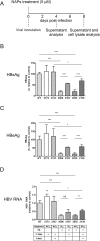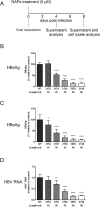Inhibition of hepatitis B viral entry by nucleic acid polymers in HepaRG cells and primary human hepatocytes
- PMID: 28636622
- PMCID: PMC5479567
- DOI: 10.1371/journal.pone.0179697
Inhibition of hepatitis B viral entry by nucleic acid polymers in HepaRG cells and primary human hepatocytes
Abstract
Hepatitis B virus (HBV) infection remains a major public health concern worldwide with 240 million individuals chronically infected and at risk of developing cirrhosis and hepatocellular carcinoma. Current treatments rarely cure chronic hepatitis B infection, highlighting the need for new anti-HBV drugs. Nucleic acid polymers (NAPs) are phosphorothioated oligonucleotides that have demonstrated a great potential to inhibit infection with several viruses. In chronically infected human patients, NAPs administration lead to a decline of blood HBsAg and HBV DNA and to HBsAg seroconversion, the expected signs of functional cure. NAPs have also been shown to prevent infection of duck hepatocytes with the Avihepadnavirus duck hepatitis B virus (DHBV) and to exert an antiviral activity against established DHBV infection in vitro and in vivo. In this study, we investigated the specific anti-HBV antiviral activity of NAPs in the HepaRG human hepatoma cell line and primary cultures of human hepatocytes. NAPs with different chemical features (phosphorothioation, 2'O-methyl ribose, 5-methylcytidine) were assessed for antiviral activity when provided at the time of HBV inoculation or post-inoculation. NAPs dose-dependently inhibited HBV entry in a phosphorothioation-dependent, sequence-independent and size-dependent manner. This inhibition of HBV entry by NAPs was impaired by 2'O-methyl ribose modification. NAP treatment after viral inoculation did not elicit any antiviral activity.
Conflict of interest statement
Figures





Similar articles
-
Nucleic Acid Polymers Are Active against Hepatitis Delta Virus Infection In Vitro.J Virol. 2018 Jan 30;92(4):e01416-17. doi: 10.1128/JVI.01416-17. Print 2018 Feb 15. J Virol. 2018. PMID: 29212929 Free PMC article.
-
Nucleic acid polymers inhibit duck hepatitis B virus infection in vitro.Antimicrob Agents Chemother. 2013 Nov;57(11):5291-8. doi: 10.1128/AAC.01003-13. Epub 2013 Aug 12. Antimicrob Agents Chemother. 2013. PMID: 23939902 Free PMC article.
-
Nucleic acid-based polymers effective against hepatitis B Virus infection in patients don't harbor immunostimulatory properties in primary isolated liver cells.Sci Rep. 2017 Mar 8;7:43838. doi: 10.1038/srep43838. Sci Rep. 2017. PMID: 28272460 Free PMC article.
-
Nucleic acid polymers: Broad spectrum antiviral activity, antiviral mechanisms and optimization for the treatment of hepatitis B and hepatitis D infection.Antiviral Res. 2016 Sep;133:32-40. doi: 10.1016/j.antiviral.2016.07.004. Epub 2016 Jul 9. Antiviral Res. 2016. PMID: 27400989 Review.
-
Viral and cellular determinants involved in hepadnaviral entry.World J Gastroenterol. 2007 Jan 7;13(1):22-38. doi: 10.3748/wjg.v13.i1.22. World J Gastroenterol. 2007. PMID: 17206752 Free PMC article. Review.
Cited by
-
Nucleic acid polymer REP 2139 and nucleos(T)ide analogues act synergistically against chronic hepadnaviral infection in vivo in Pekin ducks.Hepatology. 2018 Jun;67(6):2127-2140. doi: 10.1002/hep.29737. Epub 2018 Feb 23. Hepatology. 2018. PMID: 29251788 Free PMC article.
-
Activity of nucleic acid polymers in rodent models of HBV infection.Antiviral Res. 2018 Jan;149:26-33. doi: 10.1016/j.antiviral.2017.10.022. Epub 2017 Nov 8. Antiviral Res. 2018. PMID: 29126900 Free PMC article.
-
New Approaches to the Treatment of Chronic Hepatitis B.J Clin Med. 2020 Oct 1;9(10):3187. doi: 10.3390/jcm9103187. J Clin Med. 2020. PMID: 33019573 Free PMC article. Review.
-
Nucleic Acid Polymers Are Active against Hepatitis Delta Virus Infection In Vitro.J Virol. 2018 Jan 30;92(4):e01416-17. doi: 10.1128/JVI.01416-17. Print 2018 Feb 15. J Virol. 2018. PMID: 29212929 Free PMC article.
-
Editorial: In vitro mechanistic evaluation of nucleic acid polymers: A cautionary tale.Mol Ther Nucleic Acids. 2022 Mar 23;28:168-174. doi: 10.1016/j.omtn.2022.03.002. eCollection 2022 Jun 14. Mol Ther Nucleic Acids. 2022. PMID: 35402067 Free PMC article.
References
-
- Trépo C, Chan HLY, Lok A. Hepatitis B virus infection. Lancet Lond Engl. 2014;384: 2053–2063. doi: 10.1016/S0140-6736(14)60220-8 - DOI - PubMed
-
- Lozano R, Naghavi M, Foreman K, Lim S, Shibuya K, Aboyans V, et al. Global and regional mortality from 235 causes of death for 20 age groups in 1990 and 2010: a systematic analysis for the Global Burden of Disease Study 2010. Lancet Lond Engl. 2012;380: 2095–2128. doi: 10.1016/S0140-6736(12)61728-0 - DOI - PMC - PubMed
-
- Ganem D, Prince AM. Hepatitis B virus infection—natural history and clinical consequences. N Engl J Med. 2004;350: 1118–1129. doi: 10.1056/NEJMra031087 - DOI - PubMed
-
- Kondo Y, Ninomiya M, Kakazu E, Kimura O, Shimosegawa T. Hepatitis B surface antigen could contribute to the immunopathogenesis of hepatitis B virus infection. ISRN Gastroenterol. 2013;2013: 935295 doi: 10.1155/2013/935295 - DOI - PMC - PubMed
-
- Zhu D, Liu L, Yang D, Fu S, Bian Y, Sun Z, et al. Clearing Persistent Extracellular Antigen of Hepatitis B Virus: An Immunomodulatory Strategy To Reverse Tolerance for an Effective Therapeutic Vaccination. J Immunol Baltim Md 1950. 2016;196: 3079–3087. doi: 10.4049/jimmunol.1502061 - DOI - PMC - PubMed
MeSH terms
Substances
LinkOut - more resources
Full Text Sources
Other Literature Sources
Research Materials

